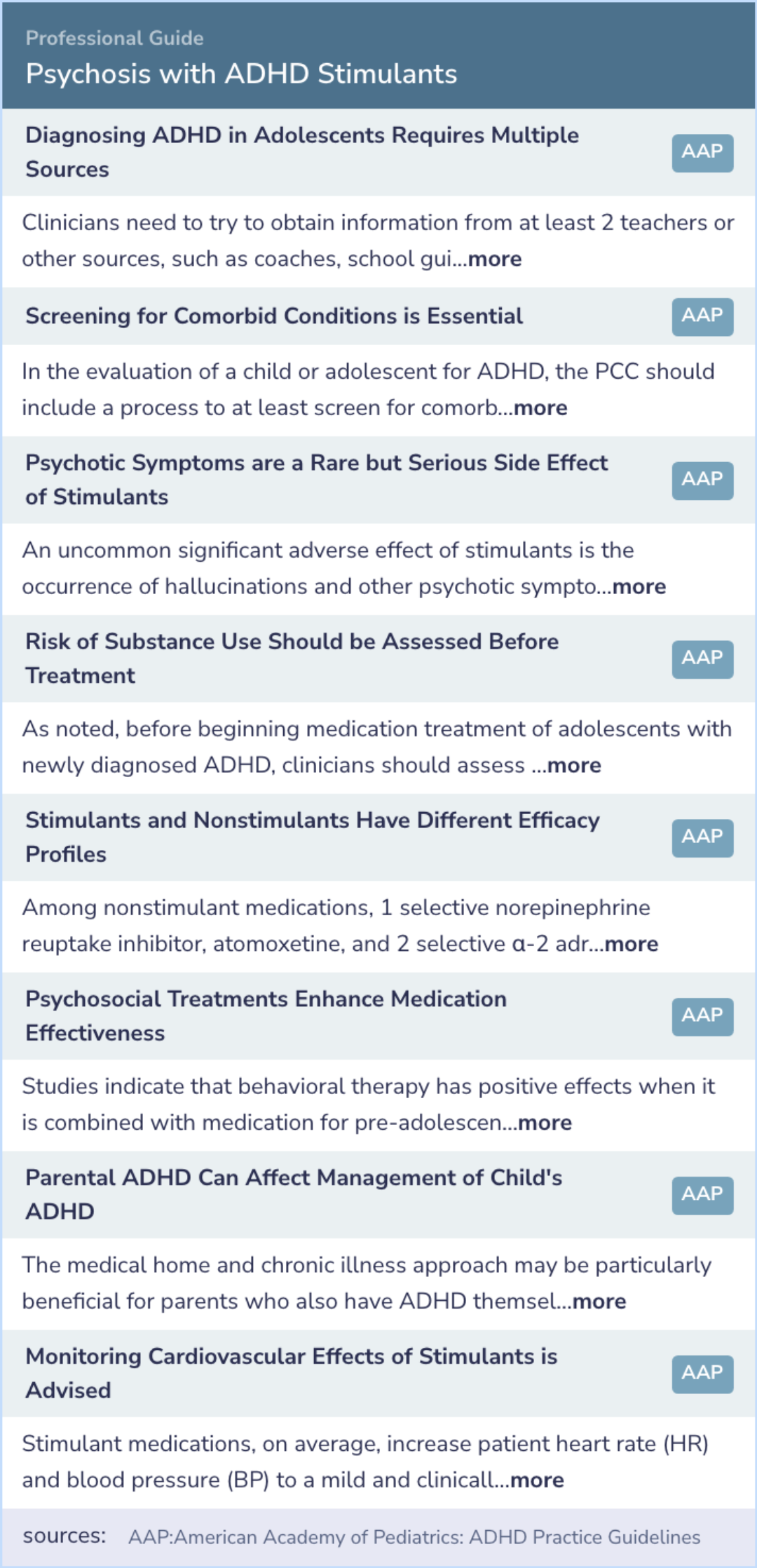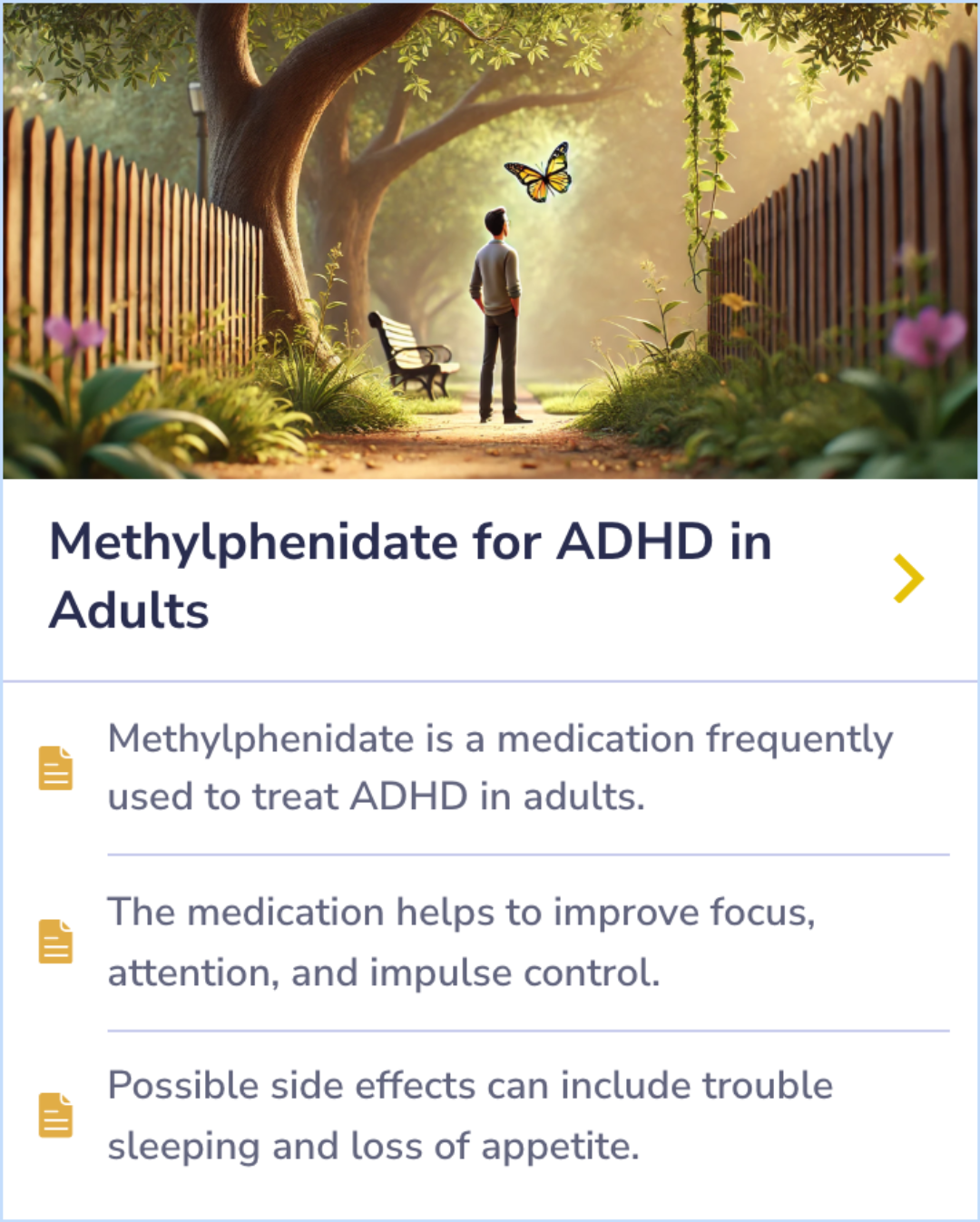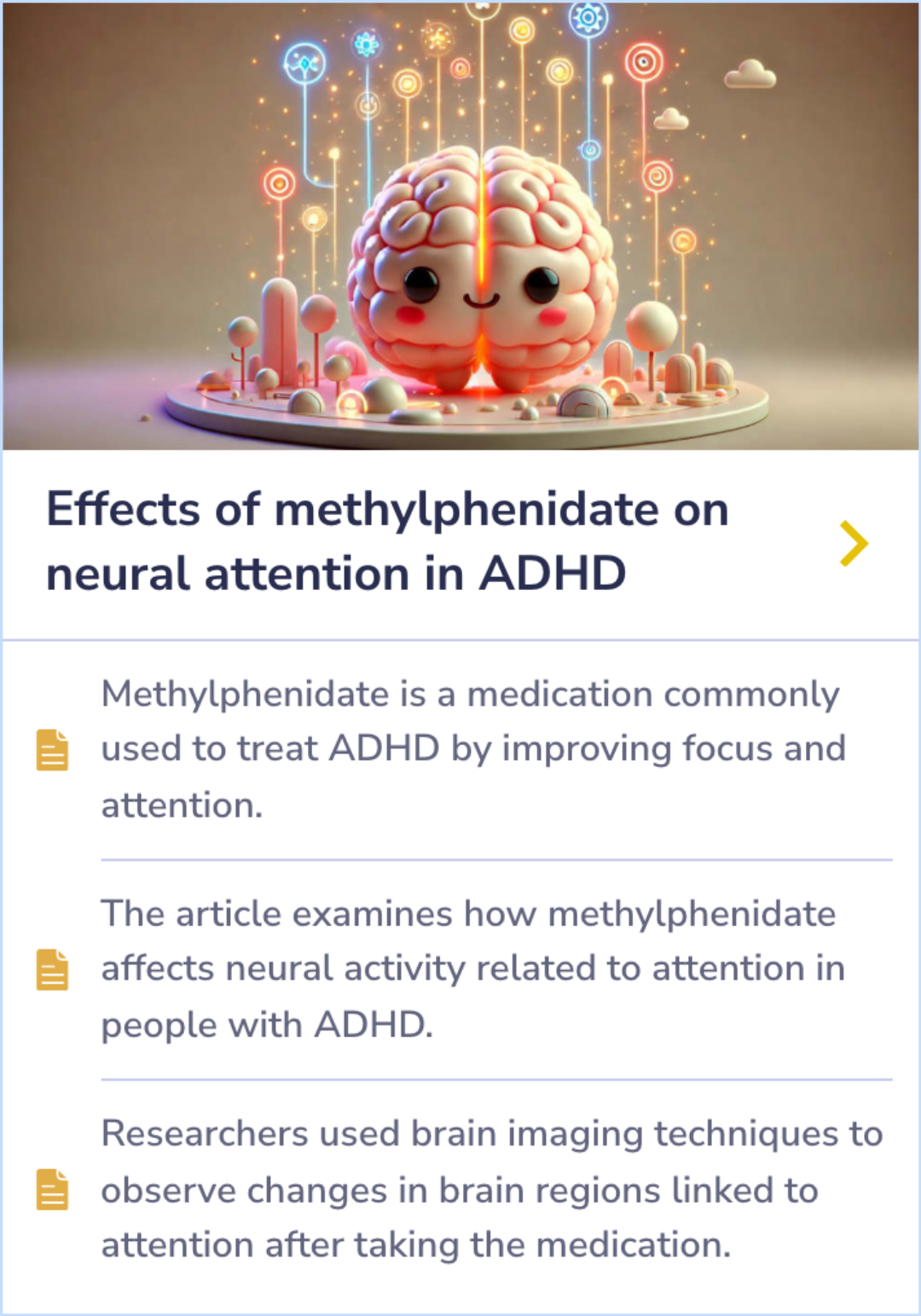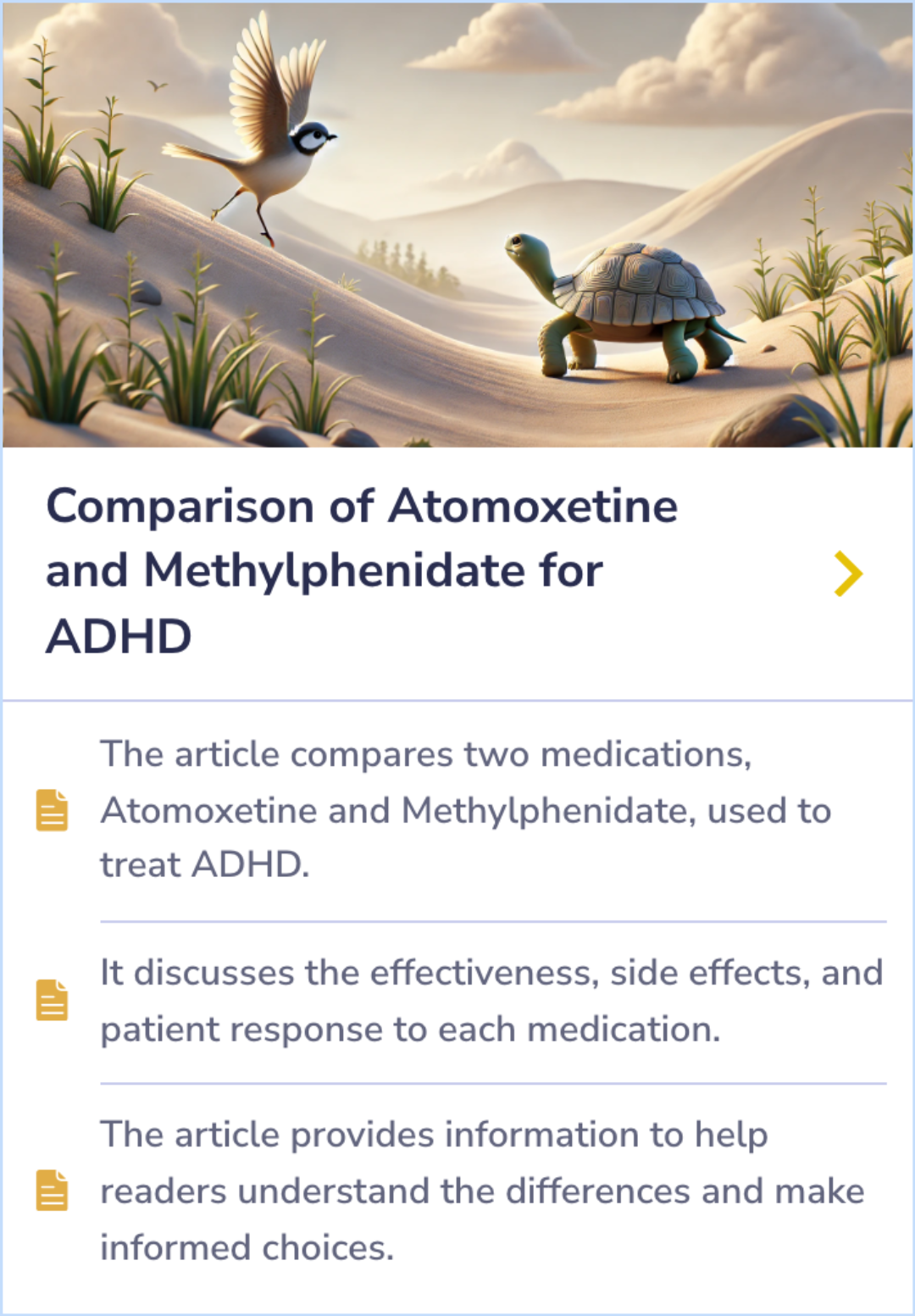Ritalin Paper Database
Visual Abstract
Psychosis with Methylphenidate or Amphetamine in Patients with ADHD
Psychosis with ADHD Stimulants
August 27, 2024
author
Moran LV, Ongur D, Hsu J, Castro VM, Perlis RH, Schneeweiss S
journal
N Engl J Med
Date Published
2019 Mar 21
Why link to a visual abstract?
What is a visual abstract?
Original
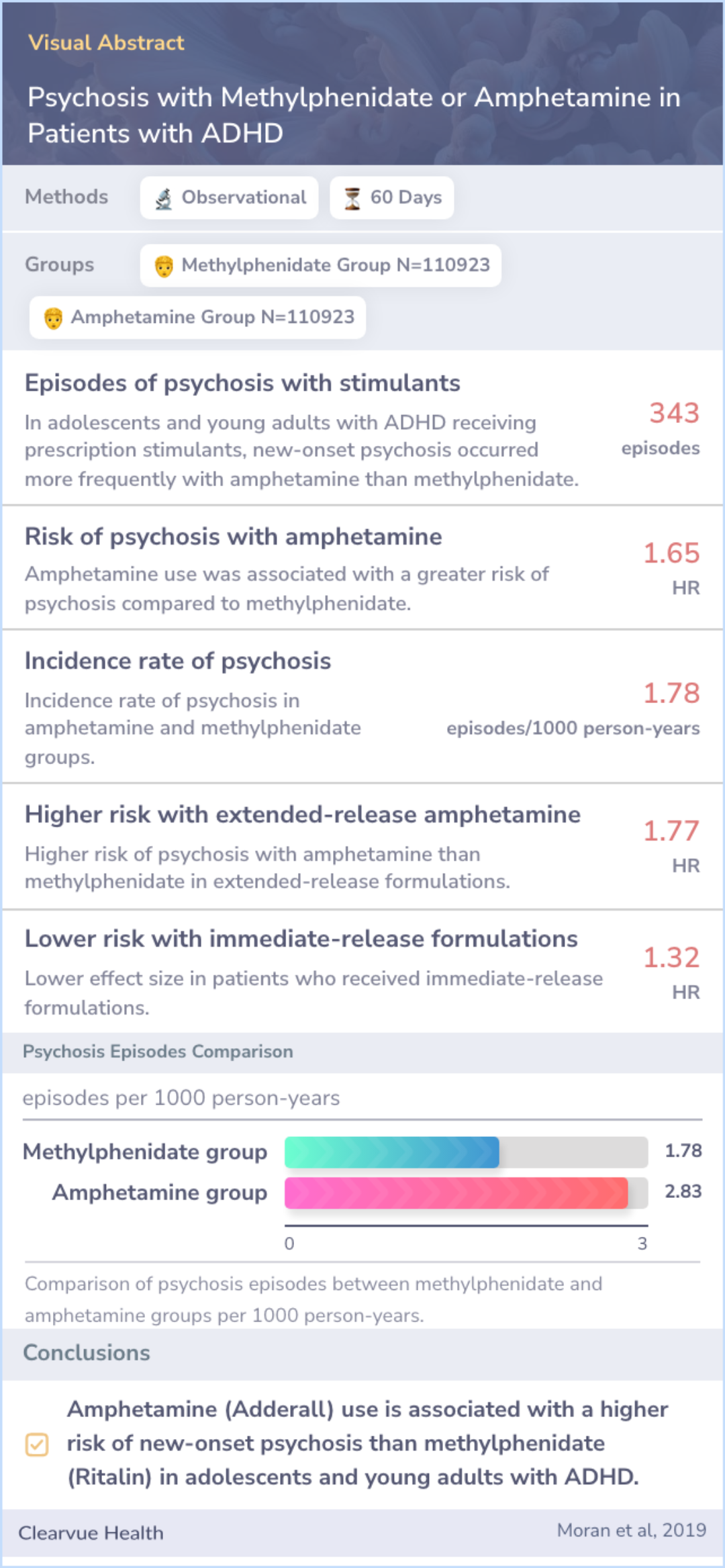
Study Summary
🔬
What They Studied
They studied whether the risk of new-onset psychosis differs between adolescents and young adults with ADHD using methylphenidate (Ritalin) or amphetamine (Adderall).
💡
What They Found
They found that the risk of new-onset psychosis was higher in those using amphetamine (Adderall) compared to those using methylphenidate (Ritalin).
📚
What This Means
These findings mean that for adolescents and young adults with ADHD, using amphetamine (Adderall) is linked to a greater risk of developing psychosis than using methylphenidate (Ritalin), aligning with current evidence on stimulant risks.
Study Summary
Study Overview
The study aimed to understand whether different stimulant medications used to treat ADHD, specifically methylphenidate (Ritalin) and amphetamine (Adderall), pose different risks for developing new-onset psychosis in adolescents and young adults. ADHD is a common condition treated with stimulant medications, which have been increasing in prescription rates, especially among young people. Understanding the potential side effects of these medications is crucial for ensuring safe treatment options.
The study found that the risk of new-onset psychosis was higher for those using amphetamine compared to those using methylphenidate. This was observed consistently across different national healthcare databases, and the findings were supported by various methods to reduce bias. The results suggest that the biological mechanisms of these medications on neurotransmitters might explain the differences in psychosis risk. However, it is important to note that there are several limitations, including potential unmeasured factors such as substance use disorders, which could have influenced the results. Despite these limitations, the findings provide valuable insights into the safety profiles of these commonly used ADHD medications.
The study found that the risk of new-onset psychosis was higher for those using amphetamine compared to those using methylphenidate. This was observed consistently across different national healthcare databases, and the findings were supported by various methods to reduce bias. The results suggest that the biological mechanisms of these medications on neurotransmitters might explain the differences in psychosis risk. However, it is important to note that there are several limitations, including potential unmeasured factors such as substance use disorders, which could have influenced the results. Despite these limitations, the findings provide valuable insights into the safety profiles of these commonly used ADHD medications.
Abstract: background
The prescription use of the stimulants methylphenidate and amphetamine for the treatment of attention deficit-hyperactivity disorder (ADHD) has been increasing. In 2007, the Food and Drug Administration mandated changes to drug labels for stimulants ...more

Higher Risk of Psychosis
"Amphetamine use was associated with a greater risk of psychosis than methylphenidate."
Biological Mechanisms
"The different biologic mechanisms of methylphenidate and amphetamine activity on neurotransmitters could explain our findings."
Increasing Use
"The prescription use of the stimulants methylphenidate and amphetamine for the treatment of attention deficit-hyperactivity disorder (ADHD) has been increasing."
Study Summary
Methods
Researchers used data from two commercial insurance claims databases, focusing on patients aged 13 to 25 who had ADHD and started taking either methylphenidate (Ritalin) or amphetamine (Adderall) between 2004 and 2015. The main outcome was a new diagnosis of psychosis within the first 60 days of starting the medication, marked by a prescription for an antipsychotic drug.
To compare the risk of psychosis between the two drugs, they used a method called propensity score matching, ensuring patients on methylphenidate were matched with similar patients on amphetamine. The results from the two databases were then combined to get an overall picture.
To compare the risk of psychosis between the two drugs, they used a method called propensity score matching, ensuring patients on methylphenidate were matched with similar patients on amphetamine. The results from the two databases were then combined to get an overall picture.
Abstract: methods
We used data from two commercial insurance claims databases to assess patients 13 to 25 years of age who had received a diagnosis of ADHD and who started taking methylphenidate or amphetamine between January 1, 2004, and September 30, 2015. The outco...more

Study Summary
Results
The study assessed 337,919 adolescents and young adults prescribed stimulants for ADHD. After matching, 110,923 patients on methylphenidate were compared with 110,923 patients on amphetamine, resulting in 221,846 total patients with 143,286 person-years of follow-up. There were 343 episodes of psychosis recorded, translating to about 2.4 cases per 1,000 person-years.
Specifically, the methylphenidate group had 106 cases (0.10%), while the amphetamine group had 237 cases (0.21%). This indicates that amphetamine users had a 1.65 times higher risk of developing psychosis compared to those using methylphenidate.
Specifically, the methylphenidate group had 106 cases (0.10%), while the amphetamine group had 237 cases (0.21%). This indicates that amphetamine users had a 1.65 times higher risk of developing psychosis compared to those using methylphenidate.
Abstract: results
We assessed 337,919 adolescents and young adults who received a prescription for a stimulant for ADHD. The study population consisted of 221,846 patients with 143,286 person-years of follow up; 110,923 patients taking methylphenidate were matched wit...more
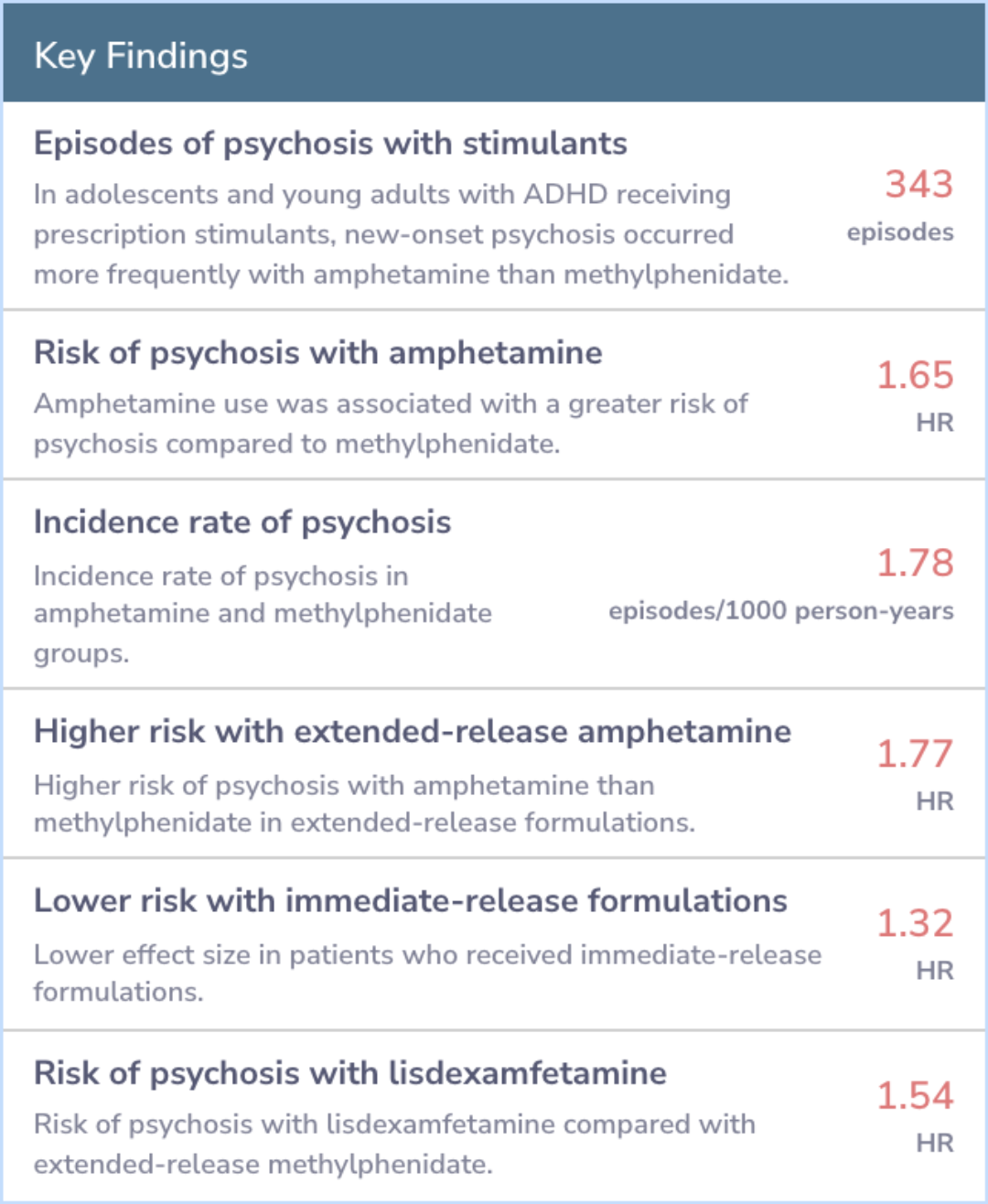
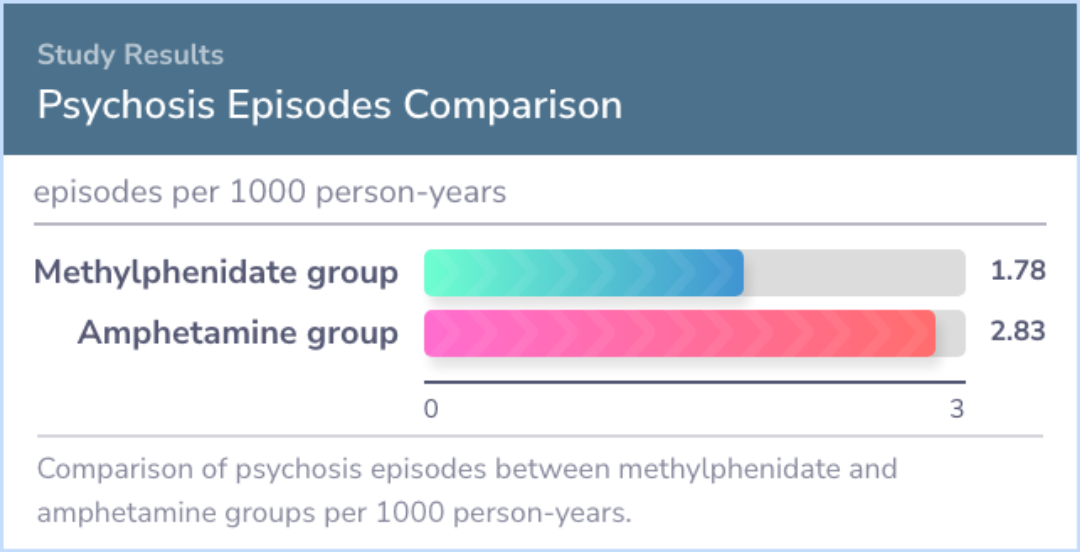
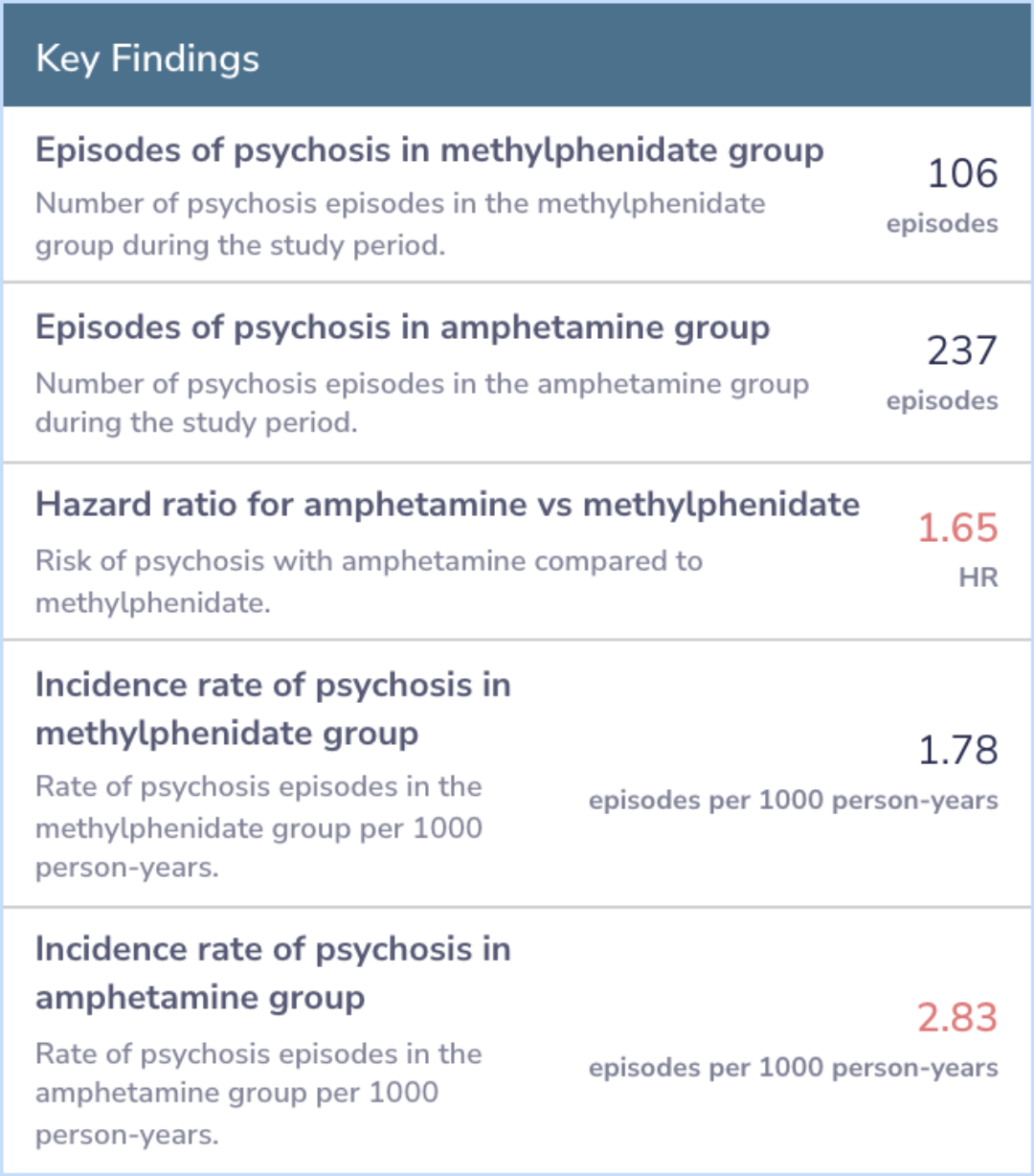
Study Summary
Conclusions
For adolescents and young adults with ADHD, new-onset psychosis occurred in roughly 1 in 660 patients taking prescription stimulants. The study found that amphetamine (Adderall) use was linked to a significantly higher risk of psychosis compared to methylphenidate (Ritalin).
These findings highlight the importance of considering the type of stimulant prescribed for ADHD, as amphetamine poses a greater psychosis risk. The study was funded by the National Institute of Mental Health and other organizations.
These findings highlight the importance of considering the type of stimulant prescribed for ADHD, as amphetamine poses a greater psychosis risk. The study was funded by the National Institute of Mental Health and other organizations.
Abstract: conclusions
Among adolescents and young adults with ADHD who were receiving prescription stimulants, new-onset psychosis occurred in approximately 1 in 660 patients. Amphetamine use was associated with a greater risk of psychosis than methylphenidate. (Funded by...more
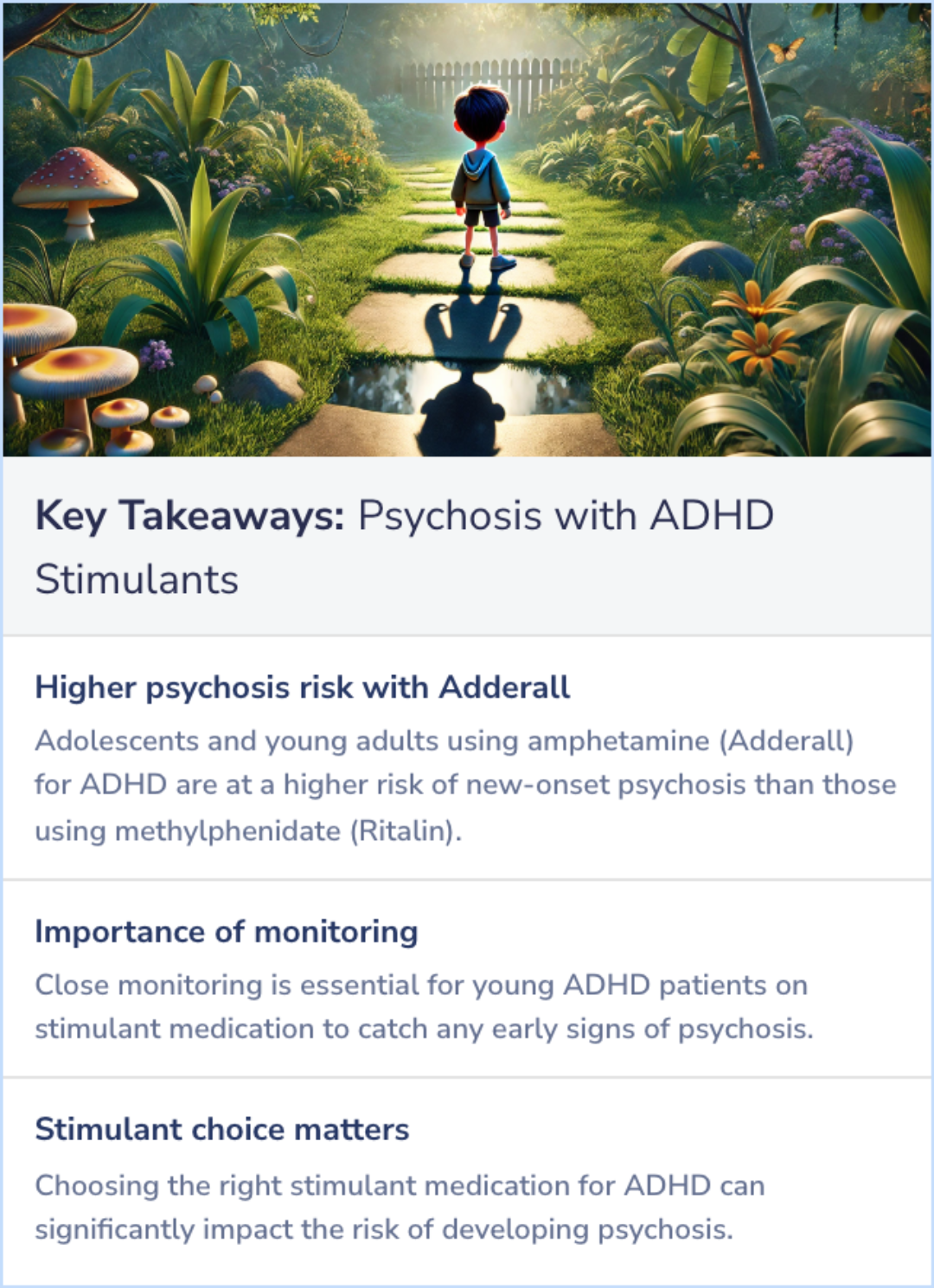
Background Information
Patient Guide
🧠
Methylphenidate's Psychiatric Risks
Methylphenidate can aggravate symptoms of psychosis or bipolar disorder and may cause new or worsened aggressive behavior.
👨⚕️
FDA Approval for ADHD
Methylphenidate is FDA-approved for treating ADHD in children and adults, highlighting its widespread use in this population.
🧠
Mechanism of Action
Methylphenidate blocks norepinephrine and dopamine reuptake, increasing their concentration in the synaptic cleft, which impacts neurotransmission.
❤️
Cardiovascular Concerns
Stimulants like methylphenidate can exacerbate symptoms like palpitations and are not recommended for patients with serious heart conditions.
👀
Monitoring and Side Effects
Regular monitoring for side effects such as cardiovascular issues, psychiatric reactions, and growth suppression is necessary.
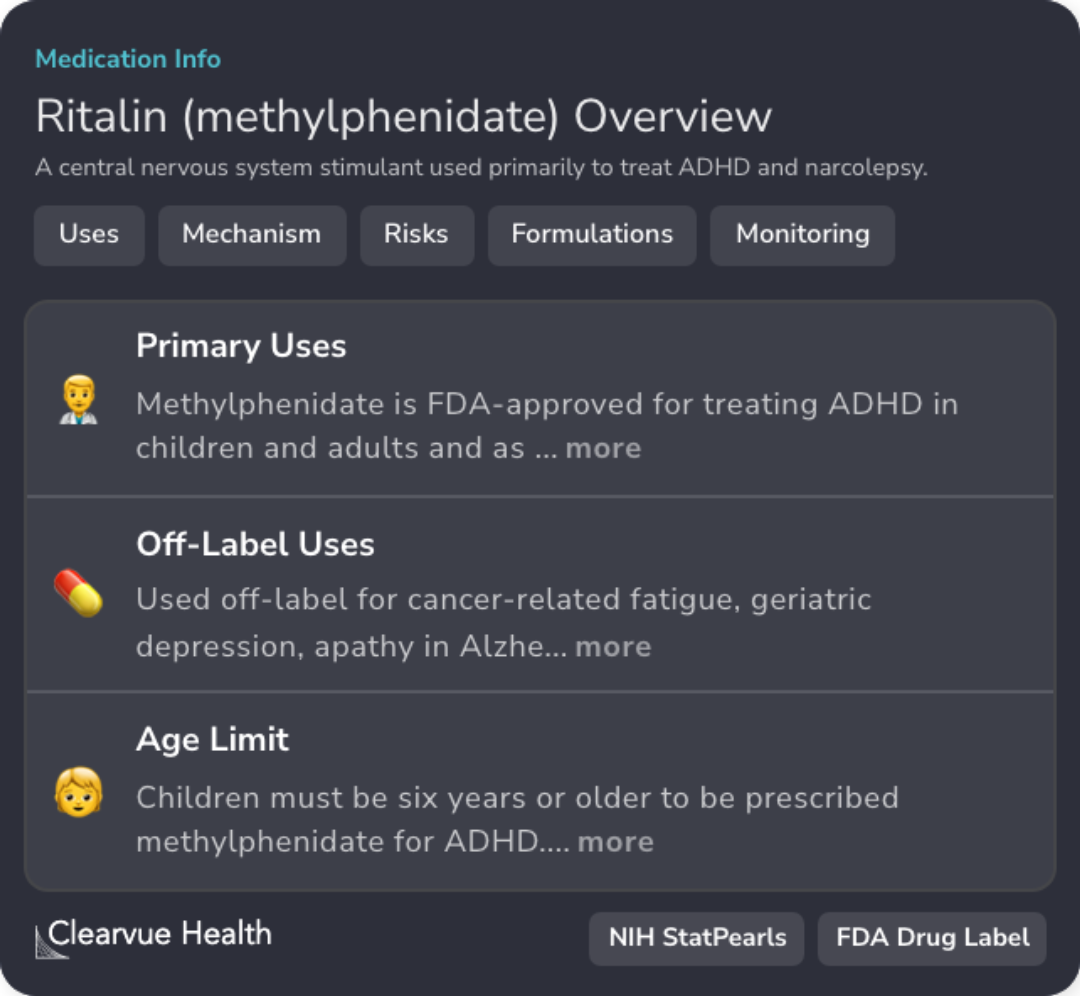
Professional Guide
Expert Opinion: Psychosis with ADHD Stimulants
The findings suggest that amphetamine use poses a higher risk of new-onset psychosis in adolescents and young adults compared to methylphenidate.
Screening for comorbid conditions and substance use before initiating ADHD treatment is crucial.
Psychotic symptoms, though rare, are a serious side effect of stimulant medications.
Nonstimulant medications also provide symptom relief, but with lesser efficacy.
Combining behavioral therapy with medication enhances treatment effectiveness.
Monitoring cardiovascular effects in patients receiving stimulant treatment is advised.
Screening for comorbid conditions and substance use before initiating ADHD treatment is crucial.
Psychotic symptoms, though rare, are a serious side effect of stimulant medications.
Nonstimulant medications also provide symptom relief, but with lesser efficacy.
Combining behavioral therapy with medication enhances treatment effectiveness.
Monitoring cardiovascular effects in patients receiving stimulant treatment is advised.
Evidence Summary
Methylphenidate for Adult ADHD: Benefits and Side Effects
Methylphenidate is frequently used to treat ADHD in adults, enhancing focus and impulse control. However, users may experience insomnia and reduced appetite as side effects.
This medication helps adults manage ADHD by improving attention and reducing impulsivity. Yet, it's paramount to be aware of potential side effects like trouble sleeping and loss of appetite.
This medication helps adults manage ADHD by improving attention and reducing impulsivity. Yet, it's paramount to be aware of potential side effects like trouble sleeping and loss of appetite.
Evidence Summary
Methylphenidate's Impact on ADHD Brain Activity
Researchers explored how methylphenidate, commonly used to treat ADHD, impacts attention-related brain activity. Brain imaging revealed changes in regions responsible for attention in individuals with ADHD after they took the medication. This examination illustrates the medication's role in enhancing focus by affecting neural activity.
Advanced techniques in brain imaging allowed scientists to observe these subtle yet significant changes, highlighting the medication's influence on the brain.
Advanced techniques in brain imaging allowed scientists to observe these subtle yet significant changes, highlighting the medication's influence on the brain.
Evidence Summary
Atomoxetine vs. Methylphenidate: A Comparative Analysis
When examining ADHD medications, the article dives into Atomoxetine and Methylphenidate, providing a comparative analysis. It details their effectiveness, side effects, and patient reactions, giving readers insights to distinguish between the two. This information aids in grasping how each medication uniquely impacts those with ADHD.
Understanding these differences is useful for appreciating how patient experiences may vary with each prescription.
This comparison helps readers make more informed decisions about ADHD treatment options.
Understanding these differences is useful for appreciating how patient experiences may vary with each prescription.
This comparison helps readers make more informed decisions about ADHD treatment options.
